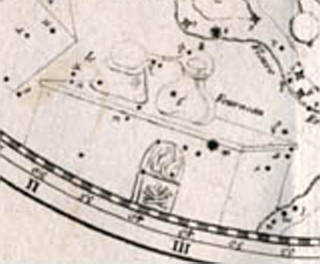¡SkyCaramba! Weekly astronomy blog for the week ending December 7, 2013
There’s a mostly unknown constellation that crosses the evening skies of December, near the more well known sea monster Cetus. The main part of the constellation is usually described as having only two stars, although some people draw it with three. The constellation is called Fornax.
some people draw it with three. The constellation is called Fornax.
That’s the Latin word for furnace. If you live in the northern hemisphere, you may immediately think it’s named for the furnace that heats your home this time of year. You would be wrong. It’s named for the apparatus chemists used a few hundred years ago to heat up chemicals.
To say the storytellers have overlooked this patch of sky may be an understatement. The ancients left us no mythology for it. There was a Roman goddess named Fornax, but she had nothing to do with any constellations. This constellation didn’t get named until 1756 when French astronomer Nicolas Louis de La Caille drew a constellation chart and decided this area needed something in it.
 La Caille’s original name for the dots he connected was Fornax Chemica which means chemical furnace. The constellation went through a few partial name changes over the next century. Fornax is what it’s been called since about 1850.
La Caille’s original name for the dots he connected was Fornax Chemica which means chemical furnace. The constellation went through a few partial name changes over the next century. Fornax is what it’s been called since about 1850.
Don’t overlook Fornax if you own binoculars or a telescope and live south of about 45° north. The bright star Alpha Fornaci, sometimes called Dalim or Fornacis, is a binary. The dimmer companion is revealed with some magnification. This pair is about 46 light years away. Beta Fornaci is 169 light years away.
With enough magnification and dark enough skies, you’ll see several galaxies in Fornax. One is called the Robin’s Egg Nebula (NGC 1360) because of its blue color and egg shape. The color stands out more in large telescopes. There’s also the Great Barred Spiral Galaxy (NGC 1365), so named because it looks like there’s a thick bar running through it perpendicular to the  most prominent spirals.
most prominent spirals.
The best time to see Fornax is at about 9pm local time in December. For most people in the northern hemisphere, that may be the only time to see Fornax. For them, it’s so far south it spends little time above the horizon. Here are some links to more information about this constellation and what’s to be found there. ¡SkyCaramba!
http://www.topastronomer.com/StarCharts/Constellations/Fornax.php
http://www.universetoday.com/20727/fornax/
http://www.constellation-guide.com/constellation-list/fornax-constellation/
